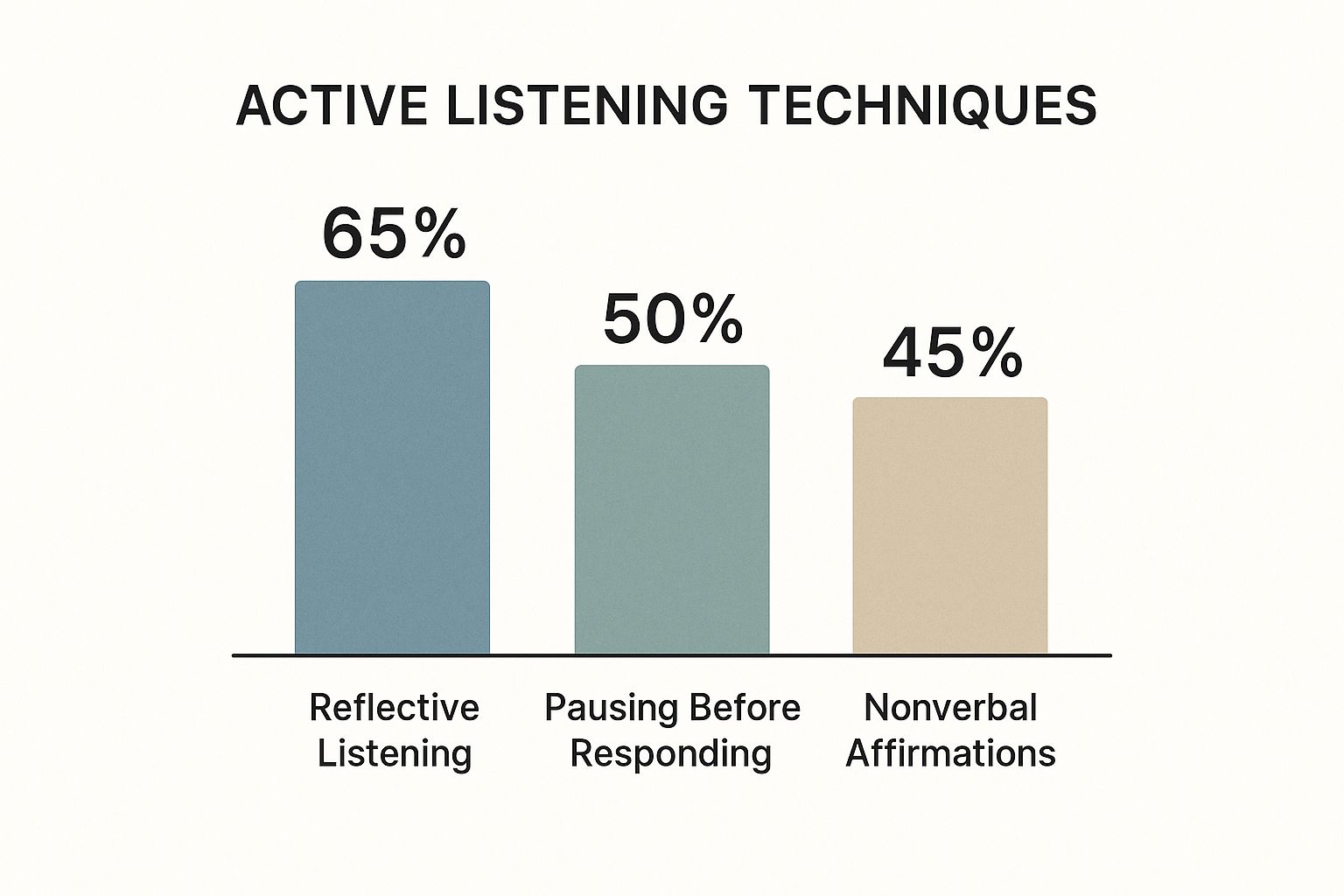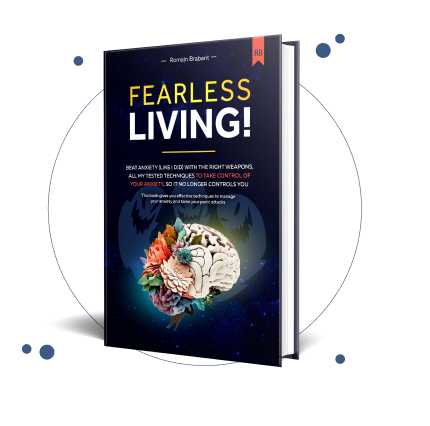
When someone you care about is struggling with anxiety, it's easy to feel helpless. I've been there, and I know that feeling all too well. You want to say the right thing, to do something that makes a difference, but you're not sure where to start.
The truth is, the best way to support them isn't about having all the answers. It’s about showing up with a mix of patient listening, gentle encouragement, and a firm belief in their ability to heal. This combination creates a safe space where they feel understood and hopeful, reminding them that recovery is not just possible, but achievable—and that you're a vital part of their journey toward a panic-free life.
Your Guide to Meaningful Anxiety Support

Watching a loved one get swept up in the overwhelming waves of anxiety is profoundly difficult. You want to fix it, but knowing what to say or do often feels like navigating a maze in the dark.
The most important first step? Approach the situation with genuine empathy and an unwavering belief that things can and will get better. Because they can. Anxiety is not a life sentence; it’s a treatable condition from which people fully recover every single day.
This guide is built on that foundation of hope. It’s designed to move beyond generic advice and give you a clear, optimistic path for helping your friend or family member find their way back to a life of freedom and joy. Your role isn't to be their therapist, but to be a steady, compassionate ally on their path to wellness and a future free from panic.
The Core of Effective Support
The journey to managing and overcoming anxiety looks different for everyone, but the principles of effective support are surprisingly constant. By focusing on these core pillars, you can make a real, positive difference and light the way forward.
Here's what it comes down to:
- Patience and Understanding: Recovery isn’t a straight line. There will be good days and bad days, but every step is part of the healing process. Your unwavering patience is a powerful reminder that progress, not perfection, is the goal.
- Encouragement Over Pressure: Gently encouraging small steps forward is far more effective than pushing for big changes. Celebrate every small victory, as each one is a building block toward a life without anxiety.
- Actionable Assistance: Sometimes, the most helpful thing you can do is something practical that makes healing feel more accessible. This could mean helping with a task that feels monumental to them or simply sitting with them in silence, reminding them they're not alone.
Your presence alone can be a powerful anchor for someone caught in a storm of anxious thoughts. It sends a clear message: "You are not alone in this, and I believe in your ability to get through it."
Ultimately, learning how to support someone with anxiety is about consistently showing up with compassion and hope. It’s about creating an environment where they feel safe enough to be vulnerable and hopeful enough to believe in a panic-free future that is waiting for them.
To give you a quick reference, here are the foundational principles of support in a nutshell.
Core Pillars of Anxiety Support at a Glance
| Pillar | What It Means in Practice | Why It's Important |
|---|---|---|
| Patience & Understanding | Accepting that recovery has ups and downs. Focusing on progress, not setbacks. | Makes them feel safe and hopeful, reinforcing that healing is a journey, not a race. |
| Encouragement, Not Pressure | Celebrating small wins. Suggesting small, manageable steps instead of big leaps. | Builds their confidence and momentum, proving that a life free from panic is achievable. |
| Practical, Non-Judgmental Help | Offering to do a specific task (e.g., "Can I pick up groceries for you?"). | Reduces their cognitive load and shows you care through actions, paving the way for recovery. |
| Active Listening | Hearing them out without immediately offering solutions or saying "don't worry." | Validates their feelings and shows that you respect their experience on their path to healing. |
Keeping these simple but powerful actions in mind will help you provide the kind of support that truly makes a difference. You don't have to be perfect—you just have to be present and hopeful.
Recognizing the Many Faces of Anxiety
To truly support someone on their path to healing, you first need to understand what you're looking at. Anxiety is a condition with many masks, and it’s so much more than just "worrying too much." The signs are often subtle shifts in behavior and physical health, but recognizing them is the first step toward helping your loved one find relief.
For instance, your loved one might seem perpetually exhausted, but this is often because their body is using immense energy to cope. Or they might complain about physical symptoms like headaches or muscle tension. These are signs that the body is carrying the weight of anxiety, but it’s a burden they can learn to set down.
Beyond the Stereotypes of Worry
While excessive worrying is a hallmark symptom, anxiety often shows up in ways that are easy to misinterpret. Think about a friend who suddenly starts canceling plans. It might not be flakiness; it could be a sign they are struggling and need support to re-engage with the world they want to be a part of.
This avoidance is a common coping mechanism, but it’s one that can be overcome. What you see as disinterest could actually be a desperate attempt to manage overwhelming feelings. In the same way, sudden irritability might just be a sign that their nervous system is overloaded and in need of calming strategies.
Recognizing these patterns is the first step toward true empathy. When you understand that their behavior is driven by a treatable condition, not choice, it changes everything. You shift from judgment to compassionate support, which is the foundation of all healing.
The scale of this issue is massive. After the COVID-19 pandemic, the number of people dealing with anxiety disorders jumped from about 298 million to an estimated 374 million worldwide. This staggering increase highlights a shared human struggle, but it also means more resources and understanding are available than ever before. So many people are finding their way out of this, and your loved one can too.
Physical and Behavioral Clues
Anxiety doesn't look the same for everyone, but knowing the signs can help you guide your loved one toward recovery. To get a better handle on this, you can check out our detailed guide on the various types of anxiety disorders.
Here are some common signs to watch for:
- Constant Fatigue: A feeling of being drained that proper rest and coping strategies can restore.
- Physical Pains: Unexplained muscle tension and headaches that can be relieved as anxiety is managed.
- Increased Irritability: A sign of an overwhelmed nervous system that can be soothed and regulated.
- Social Avoidance: A temporary retreat that can be reversed with gentle encouragement and support.
- Reassurance Seeking: A need for validation that can be replaced with self-confidence as they heal.

As the infographic shows, certain ways of listening are far more helpful than others. When you can spot these varied symptoms and respond with genuine understanding and hope, you're in a much better position to offer the right kind of support—and gently help your loved one find their way to a life with less panic and more freedom.
Communication That Calms Instead of Overwhelms

When someone you love is spiraling, your words can either be a lifeline or an anchor. The art of supporting someone with anxiety is learning to validate their struggle while instilling hope that their fears do not have to define their future.
It's a subtle but crucial distinction. Think about the difference between saying, "Don't worry, nothing bad will happen," versus, "I can see this is incredibly hard for you right now, and I know you have the strength to get through it." The first one dismisses their reality. The second one acknowledges their pain while reinforcing their power.
Your goal isn’t to "fix" their anxiety on the spot. It's to create a safe, hopeful space where they feel seen, heard, and capable of healing. That feeling of safety and empowerment is the first step toward them finding their own way forward to lasting calm.
What to Say and What to Avoid
Navigating these conversations can feel like walking on eggshells, but a few small shifts in your language can make all the difference. The key is to lead with empathy and a belief in their capacity to recover.
Your words should build a bridge to a calmer future. When someone feels truly heard and believed in, their nervous system can start to downshift, and they can begin to access their own strength.
| Instead of This… | Try This Instead… | Why It Works |
|---|---|---|
| "Just calm down." | "I'm here with you. We can breathe through this together." | This offers presence and partnership, reassuring them that calm is achievable. |
| "You're overreacting." | "This sounds incredibly stressful. I believe you can handle this." | This validates their experience while gently fostering self-belief. |
| "Don't worry about it." | "I can see how much this is affecting you. What's one small thing we could do to help you feel more in control?" | This acknowledges their pain and guides them toward empowered action. |
| "It's all in your head." | "Your feelings are valid. Let's get through this together, you're not alone." | This affirms their reality and reinforces that healing is a team effort. |
The Power of Gentle Questions and Active Listening
Beyond what you say, how you listen is your most powerful tool. This means giving them your full, uninterrupted attention and asking gentle, forward-looking questions.
Instead of the classic, "Are you okay?"—which usually gets a clipped "yes" or "no"—try something more inviting. Questions like, "What’s on your mind?" or "What would a good outcome look like here?" create space for a real conversation. It shows you’re interested in their experience and their recovery.
One of the most hopeful things you can offer is your calm, steady presence. When their world feels chaotic, your stability becomes an anchor, reminding them that the storm will pass and that calm is attainable.
Sometimes, the most supportive thing you can do is just sit with them in silence. Other times, you might gently guide them through a simple, grounding exercise.
For instance, you could say, “Let’s try to take a few slow breaths together.” This simple, collaborative act builds connection and gives them a tangible tool to find their way back to calm. If you're looking for guidance, you can find simple and effective breathing exercises for anxiety that you can learn and practice with them, empowering them with skills for life.
Practical Ways to Encourage Positive Action
While kind words are a great start, lasting healing comes from taking action. Supporting someone with anxiety means helping them take small, tangible steps forward—shifting the focus from feeling stuck to making real progress. You're not just a cheerleader; you're a partner in their recovery.
This doesn't mean you have to morph into their therapist. It's about offering practical help that empowers them to reclaim their life from anxiety. Think of yourself as a bridge between their current struggle and the bright, panic-free future that awaits them.
This switch from passive concern to active support is where you can truly make a difference. It shows them that a life without constant dread isn't just a fantasy, but a real possibility they can build, one small step at a time.
From Overwhelm to Actionable Steps
When someone is drowning in anxiety, even simple tasks can feel monumental. Your role is to help break that mountain down into small, manageable hills they can confidently climb.
If they're paralyzed by a messy room, instead of offering to clean it, try saying, "How about we just tackle that one pile of clothes together?" This collaborative approach makes the task less daunting and builds momentum.
This strategy is a game-changer for bigger challenges, like finding a therapist. You can make the process feel achievable by offering to:
- Research options with them: "Let's find a few therapists who specialize in anxiety recovery. We can look over them together and find a great fit."
- Help with that first call: "I know making that first call is a huge step. I can be right here with you for support while you do it."
- Go with them to an appointment: Just having a friendly face in the waiting room can provide a huge sense of security and reinforce that they are taking a powerful step toward wellness.
The most profound way to offer support is by gently encouraging action without applying pressure. It's the difference between saying 'You should go for a walk' and 'I'm heading out for a short walk, want to join me?' One is a demand, the other an invitation to heal.
Normalizing Professional Help and Bridging the Gap
One of the biggest hurdles to recovery is the stigma of getting professional help. But the truth is, seeking support is one of the most courageous steps a person can take.
In 2022, about 20% of adults in the United States reported anxiety symptoms. Yet, only about a quarter of those with diagnosed anxiety disorders actually get treatment. Your encouragement can be the key that unlocks the door to healing for your loved one.
You can help by framing therapy as a powerful tool for personal growth, like hiring a coach to achieve a goal. It's not a sign of weakness; it's a proactive investment in a happier, healthier future.
Alongside encouraging professional help, you can work together on small, immediate actions that build hope. Suggesting a simple breathing exercise you can do together or making a nutrient-rich meal can be incredibly empowering. Exploring how lifestyle and diet changes can support anxiety management is a great starting point.
These shared activities build connection and prove that positive change is within their grasp, right here and now.
Supporting Yourself While Supporting Them

To offer sustainable, meaningful support, you have to put on your own oxygen mask first. It’s a cliche for a reason. Caring for someone with anxiety is emotionally demanding, and you can only be a beacon of hope if your own light is shining brightly.
Your well-being isn't a luxury; it's what makes you an effective ally. Remember that you are a supporter, not a therapist. It’s not your job to "fix" them. Your role is to provide a stable, loving presence that reminds them healing is possible, and that’s only achievable if your own emotional reserves are full.
Set Healthy Boundaries to Prevent Burnout
Setting boundaries isn't selfish. It’s a vital act of self-preservation that allows you to provide long-term, effective support. Healthy boundaries protect your energy and ensure you can remain a positive, hopeful force in their life.
This means it's okay to say "no" and to take space for yourself. You can't pour from an empty cup, and your well-being is essential for the marathon of recovery.
Your support is a marathon, not a sprint. To stay in the race, you have to pace yourself, refuel, and rest. Protecting your own well-being is what allows you to show up consistently for the long haul, offering the steady, hopeful presence your loved one needs to heal.
Being firm doesn't mean being unkind. You could say something like, "I love you and I'm here for you, but I can't be on call 24/7 for emotional support. Let's find a time to talk later when I can give you my full attention." This communicates your limits while reinforcing your commitment.
Protect Your Own Mental Health
It’s vital to recognize the signs of compassion fatigue—that state of emotional and physical exhaustion that can hit hard. If you start feeling irritable, withdrawn, or hopeless, see it as a signal to prioritize your own self-care immediately.
Here are a few actionable ways to protect yourself:
- Maintain Your Own Life: Don't let their anxiety become the center of your universe. Continue investing in your own hobbies, friendships, and goals. This keeps you grounded and models a healthy, balanced life.
- Build Your Own Support System: You need people you can lean on, too. Having your own outlet to process your feelings is non-negotiable for staying strong and optimistic.
- Manage Your Energy: Supporting someone with anxiety is draining. Pay attention to your own energy levels. Some people even find that exploring things like matcha as a calmer alternative to coffee for energy and focus can make a difference.
- Seek Professional Guidance: If you find yourself struggling, remember that your mental health is a priority. Learning how to find a psychiatrist for anxiety can be a powerful step for yourself, or at least help you better understand the journey.
Even with the best intentions, you will face tough moments. Knowing how to support someone with anxiety often comes down to having practical, hopeful responses ready. Think of this as your quick-reference guide, built on the truth that a life without panic is absolutely within reach.
Your confidence in these moments can be a huge source of strength for your loved one. It shows them that anxiety is a manageable condition, not a life sentence.
What Should I Do When They Have a Panic Attack?
When a panic attack hits, your calm presence is your single most powerful tool. Reassure them they are safe and that this intense feeling will pass. Remind them that their body is strong and that they will get through this moment.
Encourage them to focus on slow, deep breaths. This helps regulate their nervous system and brings them back to the present. Avoid phrases like "just calm down." Instead, use a quiet, reassuring tone and say, "I'm right here with you. This feeling will end." Grounding techniques can be a lifesaver—try asking them to name five things they can see, reminding them they are safe in their environment.
How Can I Encourage Them to Get Professional Help?
This is a delicate conversation, so lead with empathy and hope. You might start with, "I've noticed you've been having a really hard time, and it hurts to see you in pain. I know people fully recover from this, and I'd be happy to help you find a great therapist if you're open to it."
Frame seeking help as a courageous sign of strength. Offering practical support—like researching therapists who specialize in anxiety recovery or driving them to their first appointment—can remove major hurdles. It shows you’re a true partner on their path to freedom.
The most powerful message you can send is that there is hope and a clear path forward. Recovery isn't just a vague possibility; it's an attainable goal built on small, courageous steps. Your belief in their ability to heal can be a powerful motivator.
Is It Okay to Say No to Their Requests?
Yes, and it's essential for their healing. Setting healthy boundaries is not just for your well-being; it's crucial for their long-term recovery. Enabling avoidance behaviors can unintentionally stall their progress toward living a full, panic-free life.
You can say no gently but firmly. For example, if they ask you to run an errand for them because they're too anxious, you could respond with, "I understand that feels overwhelming right now. How about we try going together? I know you can do this."
This approach validates their feelings while still encouraging a small step toward independence and self-trust. It also helps to know what sets off their anxiety. You can learn more about common anxiety triggers to better understand their experience and how to support their progress.
At The Anxiety Checklist, we believe everyone deserves to live a fearless life. Our self-help system provides the practical tools and cognitive strategies needed to manage chronic anxiety and overcome panic. To start building your personalized toolkit for sustained mental wellness, check out The Anxiety Checklist today.

